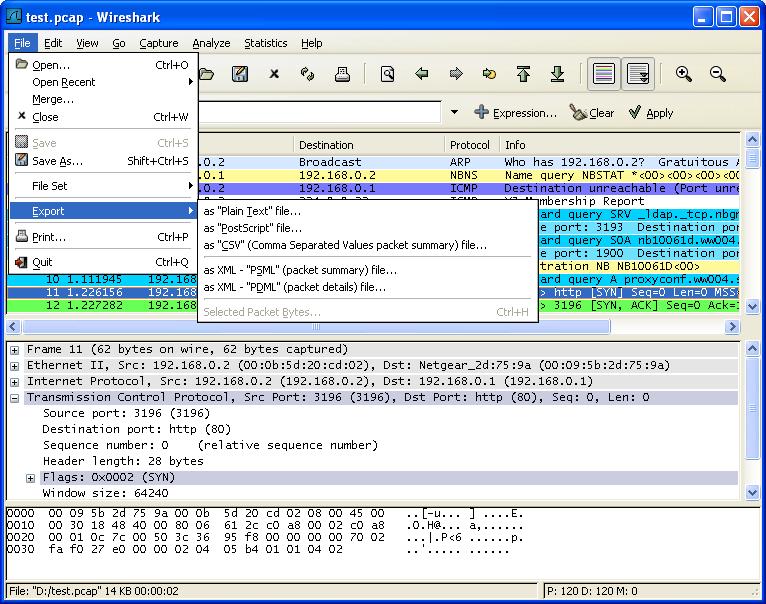The Wireshark file menu contains the fields shown in Table 3.2, “File menu items”.
Table 3.2. File menu items
| Menu Item | Accelerator | Description | ||||||
|---|---|---|---|---|---|---|---|---|
| Open... | Ctrl+O | This menu item brings up the file open dialog box that allows you to load a capture file for viewing. It is discussed in more detail in Section 5.2.1, “The "Open Capture File" dialog box”. | ||||||
| Open Recent | This menu item shows a submenu containing the recently opened capture files. Clicking on one of the submenu items will open the corresponding capture file directly. | |||||||
| Merge... | This menu item brings up the merge file dialog box that allows you to merge a capture file into the currently loaded one. It is discussed in more detail in Section 5.4, “Merging capture files”. | |||||||
| Close | Ctrl+W | This menu item closes the current capture. If you haven't saved the capture, you will be asked to do so first (this can be disabled by a preference setting). | ||||||
| ------ | ||||||||
| Save | Ctrl+S | This menu item saves the current capture. If you have not set a default capture file name (perhaps with the -w <capfile> option), Wireshark pops up the Save Capture File As dialog box (which is discussed further in Section 5.3.1, “The "Save Capture File As" dialog box”).
| ||||||
| Save As... | Shift+Ctrl+S | This menu item allows you to save the current capture file to whatever file you would like. It pops up the Save Capture File As dialog box (which is discussed further in Section 5.3.1, “The "Save Capture File As" dialog box”). | ||||||
| ------ | ||||||||
| File Set > List Files | This menu item allows you to show a list of files in a file set. It pops up the Wireshark List File Set dialog box (which is discussed further in Section 5.5, “File Sets”). | |||||||
| File Set > Next File | If the currently loaded file is part of a file set, jump to the next file in the set. If it isn't part of a file set or just the last file in that set, this item is greyed out. | |||||||
| File Set > Previous File | If the currently loaded file is part of a file set, jump to the previous file in the set. If it isn't part of a file set or just the first file in that set, this item is greyed out. | |||||||
| ------ | ||||||||
| Export > as "Plain Text" file... | This menu item allows you to export all (or some) of the packets in the capture file to a plain ASCII text file. It pops up the Wireshark Export dialog box (which is discussed further in Section 5.6.1, “The "Export as Plain Text File" dialog box”). | |||||||
| Export > as "PostScript" file... | This menu item allows you to export all (or some) of the packets in the capture file to a PostScript file. It pops up the Wireshark Export dialog box (which is discussed further in Section 5.6.2, “The "Export as PostScript File" dialog box”). | |||||||
| Export > as "CSV" (Comma Separated Values packet summary) file... | This menu item allows you to export all (or some) of the packet summaries in the capture file to a .csv file (e.g. used by spreadsheet programs). It pops up the Wireshark Export dialog box (which is discussed further in Section 5.6.3, “The "Export as CSV (Comma Separated Values) File" dialog box”). | |||||||
| Export > as "C Arrays" (packet bytes) file... | This menu item allows you to export all (or some) of the packet bytes in the capture file to a .c file so you can import the stream data into your own C program. It pops up the Wireshark Export dialog box (which is discussed further in Section 5.6.4, “The "Export as C Arrays (packet bytes) file" dialog box”). | |||||||
| ------ | ||||||||
| Export > as "PSML" file... | This menu item allows you to export all (or some) of the packets in the capture file to a PSML (packet summary markup language) XML file. It pops up the Wireshark Export dialog box (which is discussed further in Section 5.6.5, “The "Export as PSML File" dialog box”). | |||||||
| Export > as "PDML" file... | This menu item allows you to export all (or some) of the packets in the capture file to a PDML (packet details markup language) XML file. It pops up the Wireshark Export dialog box (which is discussed further in Section 5.6.6, “The "Export as PDML File" dialog box”). | |||||||
| ------ | ||||||||
| Export > Selected Packet Bytes... | Ctrl+H | This menu item allows you to export the currently selected bytes in the packet bytes pane to a binary file. It pops up the Wireshark Export dialog box (which is discussed further in Section 5.6.7, “The "Export selected packet bytes" dialog box”) | ||||||
| Objects > HTTP | This menu item allows you to export all or some of the captured HTTP objects into local files. It pops up the Wireshark HTTP object list (which is discussed further in Section 5.6.8, “The "Export Objects" dialog box”) | |||||||
| ------ | ||||||||
| Print... | Ctrl+P | This menu item allows you to print all (or some) of the packets in the capture file. It pops up the Wireshark Print dialog box (which is discussed further in Section 5.7, “Printing packets”). | ||||||
| ------ | ||||||||
| Quit | Ctrl+Q | This menu item allows you to quit from Wireshark. Wireshark will ask to save your capture file if you haven't saved it before (this can be disabled by a preference setting). |

![[Note]](wsug_graphics/note.png)